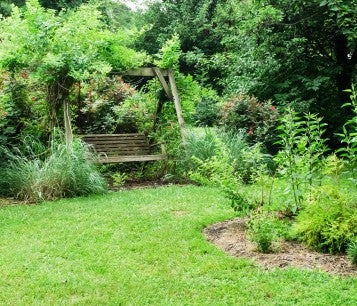As my beloved seedlings languished untouched on the display table, I improved my sales pitch: “Would you like a late-flowering thoroughwort to help migrating butterflies refuel? What about an aster that’s the only pollen source for some bee species?”
But unlike the animals who would devour these plants if given the chance, few humans were biting. Even at a festival promoting environmental awareness, I could hardly give my treasures away to customers expressing one overriding concern: “Does it spread? I don’t want anything that spreads!”
Given the dominant view of yards as static green squares, the reaction is understandable. We’re taught to believe that the nature outside our doors belongs in a box, to be kept as immobile as the wall hangings inside. The sad result? We frequently avoid species that provide critical refuge for wildlife.
The perception that procreating plants are undesirable obscures larger truths about which plants are really proliferating. As the U.S. population increases, turfgrass seems to follow us wherever we go. The nation’s number-one crop, it replaces meadows, scrublands and forests that once provided shelter and food to species now in decline.
Amid anxiety-based marketing that depicts lawns as sacrosanct, it takes courage to evaluate plants from the perspective of the animals who depend on them. The process involves unlearning long-held assumptions about the natural world. How can we know when we’re truly animal-friendly in our own backyards? If you share the following traits, you’re well on your way.
A humane backyard is a natural habitat offering wildlife plenty of food, water and cover, plus a safe place to live free from pesticides, chemicals, free-roaming pets, inhumane practices and other threats. And it's so easy to build!

You partner with top gardeners
Rabbits treat dandelions as delicacies—why not let them nibble? Squirrels and blue jays bury nuts that reforest landscapes. Skunks and opossums devour plant-eating insects. In Paige Nugent’s Ohio garden, moles do the dirty work: “I got asked by my neighbor if I wanted any mole traps. And I said, ‘No, they’re eating the Japanese beetle grubs!’ ”
You get into the “weeds”
Many lifesaving plants include “weed” in their names: Milkweed feeds monarch caterpillars, while jewelweed provides nectar for hummingbirds. Burdened by a view of native species as disruptive to agriculture, the plants are also subject to aspersions from the lawn industry. Florida gardener Loret Setters turns that phenomenon on its head by checking lawn pesticide labels and reading between the lines. “See what plants it’s going to kill,” she advises, “and those are the ones you want to keep.”
You create a hazard-free zone
Even unintentional traps—soccer netting, fallen fencing, window wells—can be harmful. A humane gardener adds well covers, stores recreational equipment and implements other preventive measures. When garden netting on a cherry tree entangled a finch many years ago, “it just horrified me,” says Colorado farmer Tammi Hartung. So she traded such products for motion-activated sprinklers and other safe deterrents.
You’re a peace negotiator
When coyotes showed up in her suburban St. Paul backyard, Minnesota gardener Lisa Taft feared for her pets’ safety. “Then I learned it was my responsibility to be careful as a dog owner,” she says. Taft keeps dogs inside when coyotes are present and leashes them after dark. She’s considering banging pots to scare her boldest visitor: “Coyotes are magnificent, beautiful, intelligent creatures, and I hate to haze them. But I know if I don’t teach him to be afraid, he may get into trouble and end up in an incident where he is killed.”
Your yard hosts lightning bugs, not artificial lighting
Firefly larvae need moisture from fallen leaves, while adults prefer naturalized grassy areas—they won’t thrive with chemicals or outdoor lighting. After converting to native plants in San Diego County, Dennis Mudd admires the glow of insects at dusk: “It’s just a whole different feeling from a regular yard.” Who needs bright lights when nature creates such magical spectacles of her own?
Want more content like this?
This was written and produced by the team behind All Animals, our award-winning magazine. Each issue is packed with inspiring stories about how we are changing the world for animals together.
Learn MoreSubscribe
